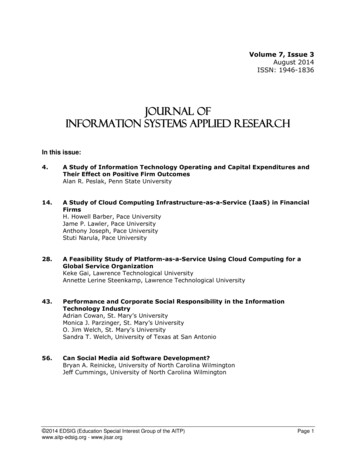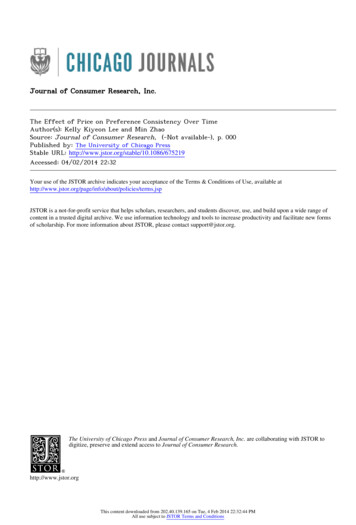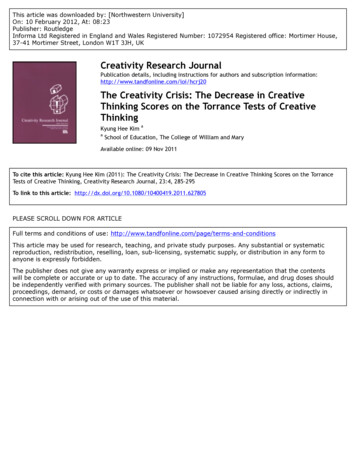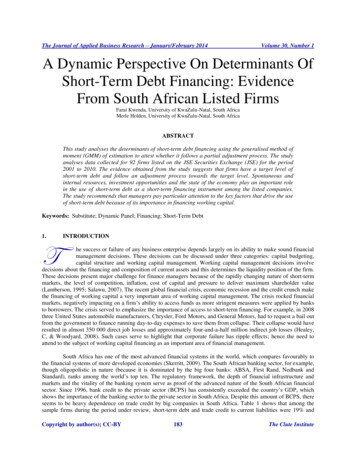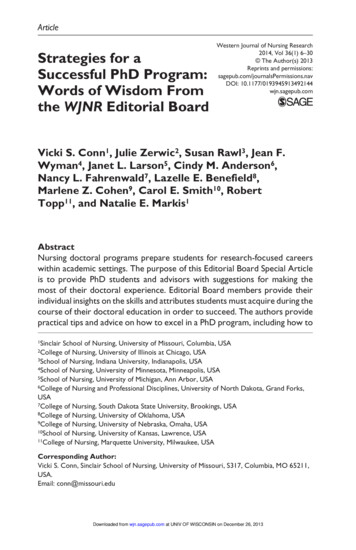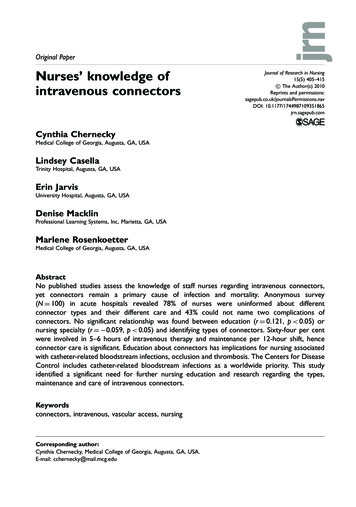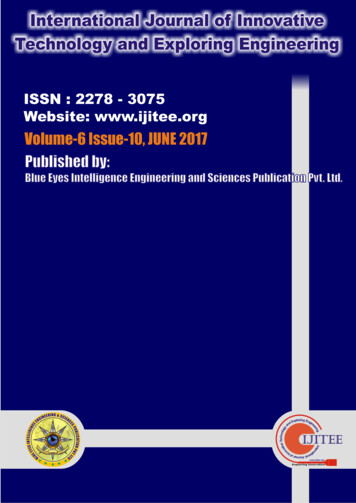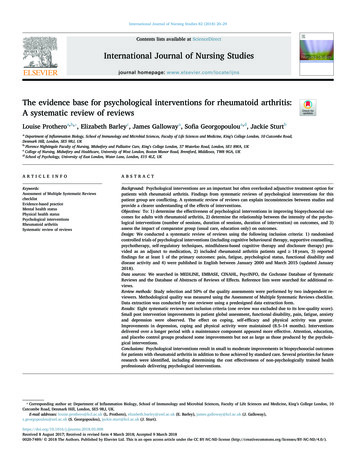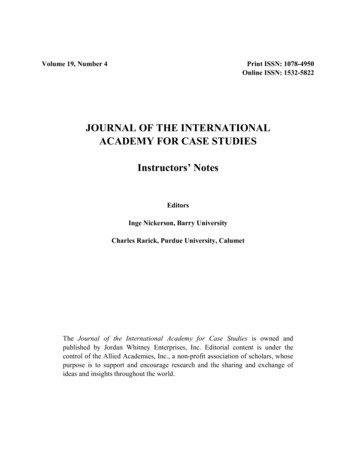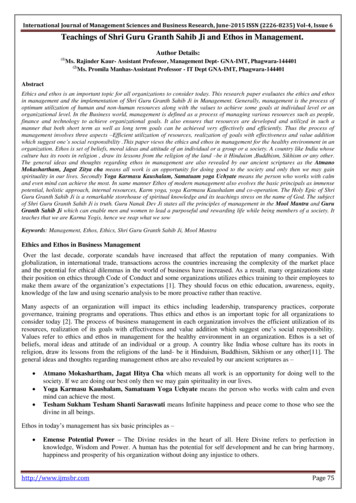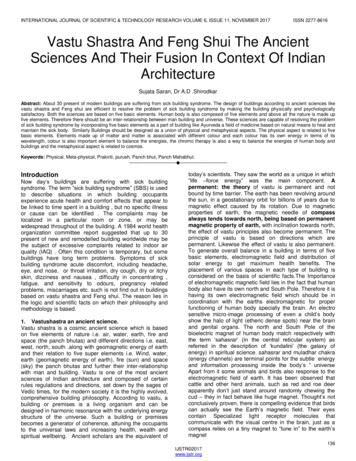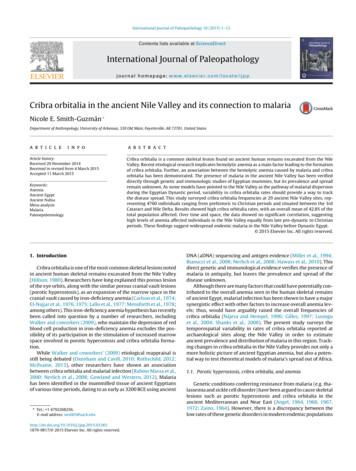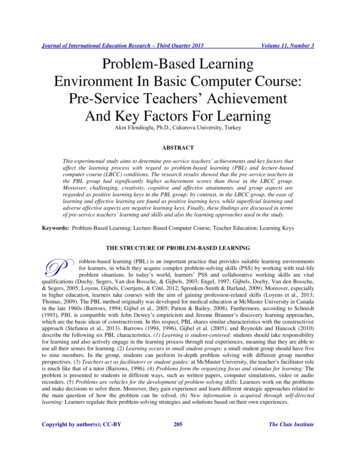
Transcription
Journal of International Education Research – Third Quarter 2015Volume 11, Number 3Problem-Based LearningEnvironment In Basic Computer Course:Pre-Service Teachers’ AchievementAnd Key Factors For LearningAkın Efendioglu, Ph.D., Cukurova University, TurkeyABSTRACTThis experimental study aims to determine pre-service teachers’ achievements and key factors thataffect the learning process with regard to problem-based learning (PBL) and lecture-basedcomputer course (LBCC) conditions. The research results showed that the pre-service teachers inthe PBL group had significantly higher achievement scores than those in the LBCC group.Moreover, challenging, creativity, cognitive and affective attainments, and group aspects areregarded as positive learning keys in the PBL group; by contrast, in the LBCC group, the ease oflearning and effective learning are found as positive learning keys, while superficial learning andadverse affective aspects are negative learning keys. Finally, these findings are discussed in termsof pre-service teachers’ learning and skills and also the learning approaches used in the study.Keywords: Problem-Based Learning; Lecture-Based Computer Course; Teacher Education; Learning KeysTHE STRUCTURE OF PROBLEM-BASED LEARNINGProblem-based learning (PBL) is an important practice that provides suitable learning environmentsfor learners, in which they acquire complex problem-solving skills (PSS) by working with real-lifeproblem situations. In today’s world, learners’ PSS and collaborative working skills are vitalqualifications (Dochy, Segers, Van den Bossche, & Gijbels, 2003; Engel, 1997; Gijbels, Dochy, Van den Bossche,& Segers, 2005; Loyens, Gijbels, Coertjens, & Côté, 2012; Spronken-Smith & Harland, 2009). Moreover, especiallyin higher education, learners take courses with the aim of gaining profession-related skills (Loyens et al., 2013;Thomas, 2009). The PBL method originally was developed for medical education at McMaster University in Canadain the late 1960s (Barrows, 1994; Gijbel et al., 2005; Parton & Bailey, 2008). Furthermore, according to Schmidt(1993), PBL is compatible with John Dewey’s empiricism and Jerome Brunner’s discovery learning approaches,which are the basic ideas of constructivism. In this respect, PBL shares similar characteristics with the constructivistapproach (Stefanou et al., 2013). Barrows (1994, 1996), Gijbel et al. (2005), and Reynolds and Hancock (2010)describe the following six PBL characteristics. (1) Learning is student-centered: students should take responsibilityfor learning and also actively engage in the learning process through real experiences, meaning that they are able touse all their senses for learning. (2) Learning occurs in small student groups: a small student group should have fiveto nine members. In the group, students can perform in-depth problem solving with different group memberperspectives. (3) Teachers act as facilitators or student guides: at McMaster University, the teacher’s facilitator roleis much like that of a tutor (Barrows, 1996). (4) Problems form the organizing focus and stimulus for learning: Theproblem is presented to students in different ways, such as written papers, computer simulations, video or audiorecorders. (5) Problems are vehicles for the development of problem-solving skills: Learners work on the problemsand make decisions to solve them. Moreover, they gain experience and learn different strategic approaches related tothe main question of how the problem can be solved. (6) New information is acquired through self-directedlearning: Learners regulate their problem-solving strategies and solutions based on their own experiences.Copyright by author(s); CC-BY205The Clute Institute
Journal of International Education Research – Third Quarter 2015Volume 11, Number 3KEY CONCEPTS AND RECENT PBL RESEARCHThe PBL approach and its effects on learning have been analyzed in several studies in the fields of naturalscience and social science. These studies have examined different PBL variables, such as self-regulated or directedlearning, conceptual understanding, motivational aspects, critical thinking, and real-life situations (Dochy et al.,2003; Gallgher, 1997; Mercier & Frederiksen, 2007; Pedersen, 2003; Stefanou et al., 2013; Sungur & Tekkaya,2006; Thomas, 2009; Yew & Schmidt, 2009). In PBL environments, learners utilize prior feedback to assess theirwork, and thus, they arrange their problem-solving approaches in terms of their own goals (self-regulated ordirected learning). In this process, students can understand the concept’s core meaning by examining priormisconceptions; furthermore, as in Bruner’s discovery learning process, they have recognized why the concept doesnot match their previous tentative conclusions (conceptual understanding). On the other hand, learners’ individuallearning efforts and awareness, i.e., their ability to manage tasks themselves in PBL environments, may positivelyawaken their affective characteristics and increase motivation (motivational aspects). Moreover, learners’ reasonablereflective thinking (critical thinking see review of Ennis, 1962) to decide “what to believe and do” (Ku, 2009) is alsorelated to these motivational aspects. Furthermore, there are many advantages to using real-life problem situations inPBL environments: (a) they are related to learners’ professions; (b) they direct learners to perform their ownresearch; (c) they require active learner participation; and (d) they provide remarkable learning environments forstudents (real-life situation).Since Barrow first published his PBL theories, numerous PBL studies have been conducted. Furthermore,in the last decade, PBL research has been published in journals in world-class databases such as Science DirectWiley, Taylor & Francis, and SAGE, which focus on medicine (see McLoughlin & Darvill, 2007; Roberts &Mitchell, 2005; Rogal & Snider, 2008; Rowan et al., 2007), social sciences (Bozic & Williams, 2011; De Simone,2008; Dunlap, 2005; Lozano et al., 2012; Pearson et al., 2007; Pourshafie, Murray-Harvey, 2013), and sciences(Araz & Sungur, 2007; Carrio et al., 2011; Pepper, 2010; Sungur, Tekkaya, & Geban, 2006), respectively. In almostall of this research, the PBL approach is used as a method to provide effective learning and develop beneficiallearning practices, such as self-direction, inquiry, meaningful learning, and conceptual understanding.COMPUTERS, PRE-SERVICE TEACHER TECHNOLOGICAL NEEDS, AND PBLOver the past thirty years, the importance of computers in human life has increased, leading to changes inalmost all research areas (social sciences, sciences, and medical sciences) and our daily lives. Moreover, computerinnovations have also changed the education system worldwide, introducing a new concept in academic literature:information communication technologies (ICTs). According to the Organization for Economic Co-operation andDevelopment (OECD), ICT is currently one of the most important aspects in education and will remain so in thefuture (OECD, 2013). The question “How should ICT be used in an education system?” introduced new ways forteachers to use their ICT knowledge and skills in classroom instruction and to effectively perform their professionalresponsibilities. Furthermore, an International Society for Technology in Education (ISTE) report (2008) suggests“teachers continuously improve their professional practice, model lifelong learning, and exhibit leadership in theirschool and professional community by promoting and demonstrating the effective use of digital tools andresources.” Additionally, teachers’ confidence regarding ICT classroom use is considered as one of the crucialaspects (European Commission, 2013, p.19). Pre-service teachers’ ICT classroom use depends on the skills theyhave gained during their in-service school experiences (Cuckle & Clarke, 2002; Wedman & Diggs, 2001).Eventually, ICT should integrate teacher education curricula and pre-service teacher training processes for effectiveinstruction (Russell, Bebell, O'Dwyer, & O'Connor, 2003).Recent research by Mueller et al. (2008) aimed to determine the discriminating factors between teacherswho fully integrate ICT in the classroom and those who do not. The study results illustrate that computer-relatedexperiences, such as positive teaching experiences, training, and motivation, are significant variables in theirclassroom use of ICT. Moreover, the results of a review study by Mumtaz (2000) showed that teachers’ formalcomputer training backgrounds significantly affected their decisions regarding ICT classroom use. In this context,computer courses have been implemented in teacher training curricula worldwide to develop pre-service teachers’ICT skills. However, it is not possible to meet pre-service teacher requirements for ICT-based skills andqualifications with traditional lecture-based methods. Lecture-based courses include three basic steps that ReynoldsCopyright by author(s); CC-BY206The Clute Institute
Journal of International Education Research – Third Quarter 2015Volume 11, Number 3and Hancock (2010) have defined as introduction, presentation of information, and end of lesson. Lecture-basedcomputer courses are slightly different from other lecture-based instruction in terms of its structure. Essentially, thelecturer starts with an introduction, presents the information, allows student application of information-relatedsample issues on their computers, and ends the lesson. In this respect, lecture-based courses obstruct studentcreativity, problem-solving skills (Hsieh & Knight, 2008) and ICT skills. To eliminate these negative outcomes andto effectively enhance student ICT skills, PBL approaches may be used in computer courses. Although most PBLresearch has used computers as technological learning tools to facilitate teaching and learning processes (seeDunlap, 2005; Kim & Pedersen, 2011; Raes, Schellens, De Weyer, & Vanderhoven, 2012), there have been quite afew studies in recent years examining PBL-based approaches to computer courses (see Baturay & Bay, 2010;Warren, Dondinger, McLeod, & Bigenho, 2012). However, none of these studies applied to pre-service teachers.While Warren et al. (2012) focused on using PBL and 3-D computer game strategies in course design, Baturay andBay (2010) used an experimental design for distance education. The present research may be the first PBL-basedexperimental study using both qualitative and quantitative approaches to provide and determine pre-service teacherICT skills.PURPOSE AND RESEARCH QUESTIONSIn the 21th century, given the importance of teachers’ ICT skills, teacher training curricula have been redesigned to incorporate technological innovations. Computer courses have been applied in teacher training programsto provide effective teacher training with regard to technological innovations. However, it may be impossible toproduce technologically innovative teachers through lecture-based computer courses. Pre-service teachers’acquisition of ICT knowledge and rules may not be sufficient for them to use ICT in solving instructional problemsituations. For effective teaching and learning, pre-service teachers need to solve real-life instructional problems,which they will encounter in classrooms. Thus, the aim of the present study is to determine pre-service teachers’learning outcomes in terms of academic achievement and key learning factors. The research questions are asfollows: Is there a significant difference in academic achievement between pre-service students in PBL and LBCCgroups?What are pre-service teachers’ views regarding the PBL and LBCC approaches as they relate to learningoutcomes, individual outcomes, individual computer skills, and the learning process?METHODDuring the spring semester of 2013, the present study was conducted in a basic computer course taken byprimary school pre-service teachers in the faculty of education. There were 187 pre-service teachers who took thecourse. The study sample (n 127) was randomly selected. Furthermore, these pre-service teachers were randomlydivided into two groups. The present research used an experimental design, including a pre- and post-test group. Inthe first group, the PBL approach was used, and the group was named “Group PBL.” In the second group, the LBCCapproach was used, and the group was named “Group LBCC.” At the end of the research process, the interviewswere conducted with 12 randomly selected pre-service teachers; half were from Group PBL, and half were fromGroup LBCC. Details of the study research design are given in Table 1.Table 1. Research designGroupspre-AchievementTest (pre-AT)Research processpost-AchievementTest (post-AT)InterviewPre-service teachers worked on aproblem into a small group (each groupX1.2has 6 or 7 members).Interview questions thepre-service teachers wereX1.1Lecturer presented course subjects to preX1.2askedservice students. After that, pre-serviceLBCCstudents worked on similar samplesubjects on computer individually.X1.1: Shows the pre-AT that applied to pre-service teachers before the research process started. X1.2: Shows the post-AT thatapplied to pre-service teachers at the end of the research process.PBLX1.1Copyright by author(s); CC-BY207The Clute Institute
Journal of International Education Research – Third Quarter 2015Volume 11, Number 3ParticipantsGroup LBCC includes 67 pre-service teachers in the same department and at the same level, but chosenrandomly from two classes. Furthermore, 42 pre-service teachers are female (62.7%), and 25 are male (37.3%); theirages range from 17 to 20 years ( 17.85; sd 0.87). In Group PBL, there are 60 pre-service teachers chosen from thesame two classes as those in Group LBCC. Of the 60 pre-service teachers, 36 are female (60%), and 24 are male(40%); their ages range from 17 to 21 years ( 17.92; sd 0.91).Research Content (Subjects)The present research was conducted on a basic computer course. Throughout the study, the basic MS Excelfeatures and 23 different Excel functions listed in Table 2 were used.Number123456789101112Table 2. List of MS Excel functionsName of functionNumberSUM( )13AVARAGE( )14SUMSQ( )15SQRT( )16FACT( )17MIN( )18MAX( )19COUNTBLANK( )20COUNTIF( )21COUNTA( )22COUNT( )23CORREL( )Name of functionLARGE( )SMALL( )IF( )AND( )OR( )RIGHT( )LEFT( )SUMIF( )MID( )ISBLANK( )CONCATENATE( )ProcedureThe present research was completed within seven weeks. In the following sections, a detailed explanation isgiven of the research procedures that were applied in both Groups PBL and LBCC.Procedure in Group PBL Introductory SeminarThe PBL approach was used in this group. A two-hour introductory course was held for pre-serviceteachers before the research process began. The aim of the introductory seminar was to provide pre-service teacherswith the critical structure of the course subjects. Within the scope of the introductory course, the general structure ofMS Excel software and five different Excel functions; each of which was selected from mathematical, statistical,logical, textual, and knowledge function categories were explained in detail to the pre-service teachers. All functionsthat were presented to pre-service teachers were distinct from the functions the research subjects were given insection 5.2. During the introductory seminar, following the lecturer’s presentation, pre-service teachers individuallyapplied samples on computers, and they asked the lecturer questions about the functions. Additionally, participantswere divided into ten different groups, each with six or seven members. After the introductory seminar, the lecturerexplained the steps for the PBL and the way participants should work during the research process.Research ProcedureEach week (a total of four course hours) the lecturer presented a problem situation to the participants at thebeginning of class. Then, each group spent two course hours working on the problem separately and trying to draft aproblem-solving plan. Moreover, each group met throughout the week to develop the draft problem-solving plan andfind a solution. For two hours at week’s end, each group projected their solutions to the other groups in the computerlaboratory, and they gave a problem report to the lecturer. The following is a sample problem situation that waspresented to the groups:Copyright by author(s); CC-BY208The Clute Institute
Journal of International Education Research – Third Quarter 2015Volume 11, Number 3“A math teacher takes four exams and gives two individual projects to evaluate students’ academic achievementduring a semester. Additionally, the teacher wants to give to students a prize as reinforcement in the mid-term.There are two types of prizes: (a) the first one is a special pencil set, and (b) the second is a pencil. The teacher usesa formulation to determine which prize is suitable for students. According to this formulation, if the total studentscore (30% of the first exam, 30% of the second exam, and 40% of the first project score) is higher than 80, he/shetakes “a”; if her/his score is between 70 and 80 he/she takes “b”; if her/his score is less than 70, he/she shouldattend a math support program. Consequently, the teacher will prepare an MS Excel table to calculate the properstudent results. How can the teacher solve this evaluation problem using an MS Excel table and functions?Procedure in Group LBCCEach week (a total of four course hours), the lecturer gave a presentation to students and explained thestructure of three functions, projecting several examples during the first two course hours. Then, students usedcomputers to work individually on the samples, and they printed Excel documents during the last two course hours.Finally, students wrote a short report about their MS Excel documents.Data Collecting ToolsThe present research used two different data collecting tools. The tools’ general structure and statisticalanalysis are given in the following sections.Academic Achievement Test (AT)There are 21 open-ended questions in AT. In the fifth question, there are three sub-questions. Moreover, inall of the questions, pre-service teachers are expected to write a proper and meaningful Excel function or acombination of proper functions. To score the items, criteria—such as (1) selecting correct function/s, (2) correctpunctuation in function/s, (3) logical integrity, and (4) selecting correct cell/s—are used to provide objectiveevaluation of pre-service teacher papers. Consequently, a correct answer is given 5 points. According to reliabilityanalysis of the AT, Cronbach’s Alpha coefficient was calculated as 0.91.Interview Form (IF)There are five open-ended questions in the interview form (IF). The comments of three experts withdoctoral degrees were considered in IF question development. Moreover, another expert with a doctoral degreechecked the questions in terms of their language structures and clarity. All interviews were conducted in theresearcher’s office and were recorded with an audio recorder. In the next phase, the researcher gave participantsstandardized names in the recorded transcripts (e.g., PBL-Student-1 , LBCC-Student-1 , etc.). Student interviewtranscripts were 42 pages in total. Then, two transcript copies were made, one that the researcher coded and theother that an independent expert with a doctoral degree coded. Following the coding process, an inductive contentanalysis method was applied. Additionally, according to the results of Miles and Huberman’s (1994) inter-coderreliability analysis, the inter-coder reliability of the IF was 0.87.FINDINGSAcademic Achievement of Pre-Service Teachers in Group PBL and Group LBCCThe t-test is performed to determine the difference between the pre-AT scores of pre-service teachers inGroup PBL and Group LBCC. The test results are given in Table 3.GroupsPBLLBCCap 0.001Table 3. T-test results between pre-AT scores of the PBL and LBCC groupsNsddft600.401.251256.3256713.0915.49Copyrigh
Problem-Based Learning Environment In Basic Computer Course: . in the LBCC group, the ease of learning and effective learning are found as positive learning keys, while superficial learning and adverse affective aspects are negative learning keys. . Bay (2010) used an experimental design for dis
